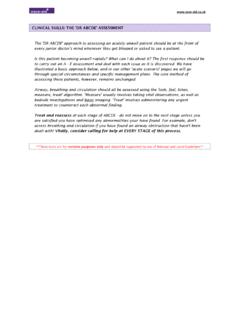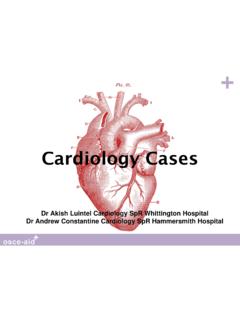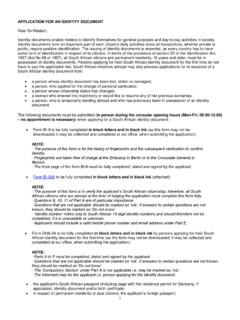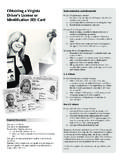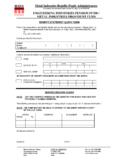Transcription of CLINICAL SKILLS: DEATH CONFIRMATION - OSCE-Aid
1 CLINICAL SKILLS: DEATH CONFIRMATION . CONFIRMATION of DEATH and DEATH certification are both tasks that you will come across during you first weeks and months working as a junior doctor. The theory and practice behind it are often examined in both OSCEs and written exams. A common scenario is to confirm DEATH on a model and then write out a DEATH certificate based on a summary of their medical notes Confirming DEATH : In this scenario, it is usually assumed that there is no indication to make a crash call or commence basic life support, although if this is ambiguous then please act safely and call for help (especially in real life).
2 When called to confirm DEATH on the ward, ensure you introduce yourself to the nursing staff looking after the patient first o Check with them if the DEATH was expected o Check whether they know the main diagnosis and have any indication about the likely cause of DEATH o Confirm the patient was not for resuscitation o Ask when the patient was found and who found them o Ensure you have the correct name, hospital number and date of birth for the patient o Ask for patient's notes Wash hands Check patient's identity on wrist band General o Introduce yourself to any relatives and staff that are by the bedside o Look at the patient's notes - check the last few entries Inspect patient o Movement?
3 : of the chest? o Colour Check for patient response by squeezing and saying patient's name Palpate o Do they have a pacemaker (firm subcutaneous object, usually found in either subclavicular regions). o Apply supraorbital pressure and check for response o Both carotid pulses and femoral pulses for 2 minutes Auscultate o The heart and the lungs for 2 minutes Eyes o Shine a torch into both eyes - if passed away, pupils should be fixed and dilated ( : adrenaline post cardiac arrest can also cause this). Cover the patient in a dignified manner Wash hands Notes: Write in the notes: o The date and time of DEATH (this is the time you finished assessing the patient) and the time the DEATH was first noted o Who you are, and who called you to see the patient o Who was there at the time you assessed the patient o The circumstances of DEATH (where was he/she found and how?)
4 O The patient did not respond to supraorbital pressure o The carotid pulses were not palpated for 2 minutes o There were no heart sounds for 2 minutes o The patient was apnoeic for 2 minutes o Both pupils were fixed and dilated o Your signature, name in full and bleep number Make arrangements for relatives to be informed Make arrangements to inform team and begin arranging the DEATH certificate Confirming brain DEATH : This is a procedure that should be carried out by qualified specialists. It should be done by 2. doctors (one of whom must be a consultant), 1 hour apart, 6h hours post commencement of coma, and 24 hours post cardiac arrest.
5 It is worth knowing the main criteria for exams. Lack of pupil reaction Lack of corneal reflex Caloric testing Lack of gag reflex Lack of cough reflex Lack of respiratory effort when taking off a ventilator After a DEATH : Give family the time they need to be with the patient Ask family what they would like to do next (different religions have different laws about how quickly ceremonies need to take place and preparation of the deceased Explain to the family that: o They can pick up the DEATH certificate the next day from the patient affairs office in the hospital o They can collect patient's personal belongings from the patient affairs office as well o They (or another representative of the patient) are required to attend local town hall to register the DEATH .)
6 They need the completed DEATH certificate to be able to do this, and it should be done within 5 days of DEATH Explain that this should be the town hall closest to the place of DEATH , not to the home place of the deceased Advise that it may be worth making an appointment to ensure that they get the privacy required (as these centres are also where births, etc are registered). Who can register a DEATH : The next of kin, a relative/person present at DEATH , during last illness, or lives where the DEATH occurred, or the person aiding in disposal of the body What to take: DEATH certificate Birth and marriage certificate NHS card What they will ask: Name and date of birth of the deceased Their occupation The place of DEATH Whether he/she received a pension The registrar will give them a green form, which is a certificate for burial/cremation, a certificate of registration of DEATH , and leaflets for the family.
7 On request, copies of the DEATH Register can be given (at least two copies advisable because banks and insurance companies expect to see them). It is up to family members to find a funeral director DEATH certification: A DEATH certificate may be issued by: o A doctor o Who has provided care during the last illness (or has been on the team that provided this care). o and who has seen the deceased after DEATH o and who is reasonably confident about the cause of DEATH o : a GP can certify DEATH without seeing the body after DEATH , so long as he/she has seen the patient within 14 days before DEATH Occasionally, circumstances occur in which the DEATH must be reported to the coroner rather than issuing a DEATH certificate.
8 Legally, this is the responsibility of the Registrar, but it is good practice (and saves time and distress for relatives) for doctors to report directly to the coroner, IF: o No doctor satisfies the attendance requirements for being able to certify DEATH the only doctor who has provided care during the last illness is away on holiday o No doctor has seen the patient within 14 days before DEATH There is doubt about cause of DEATH for any reason o Identity of deceased unknown o The cause of the DEATH is unknown o The DEATH was sudden and unexpected o It is a suspicious DEATH o It is a violent (homicide, suicide, accidental)
9 Or unnatural DEATH o The DEATH was related to surgery or anaesthetic o The DEATH was in prison or custody o The DEATH was from an industrial disease or occupational disease o The patient was in receipt of an industrial or war pension o The DEATH was by suicide, poisoning or drugs o The DEATH was as a result of an abortion o The DEATH was from neglect - hospital, care home, family, self, etc. o The DEATH was related to medications or drugs (including prescriptions). Alcohol-related deaths do not need to be referred No consent is required for a coroner post mortem (legally required) and relatives cannot refuse this 20% all deaths are coroner's case - 80% of these will end up having a post mortem You can always call the local coroner's officer if in doubt - speak to your hospital bereavement office for further information on how to do this
